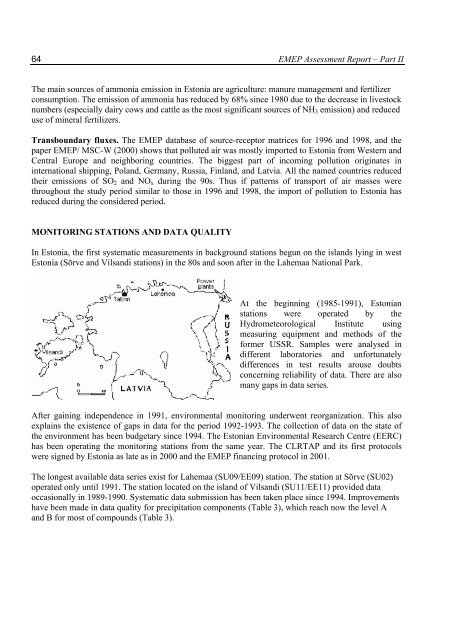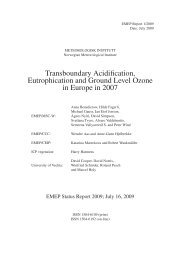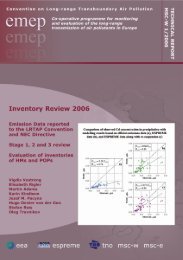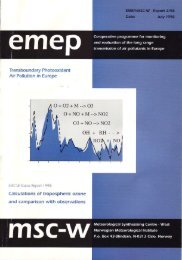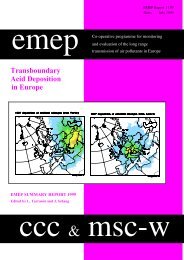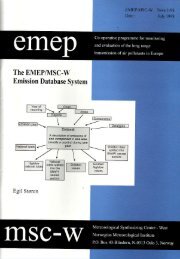Estonian EMEP Assessment Report
Estonian EMEP Assessment Report
Estonian EMEP Assessment Report
Create successful ePaper yourself
Turn your PDF publications into a flip-book with our unique Google optimized e-Paper software.
64<br />
<strong>EMEP</strong> <strong>Assessment</strong> <strong>Report</strong> – Part II<br />
The main sources of ammonia emission in Estonia are agriculture: manure management and fertilizer<br />
consumption. The emission of ammonia has reduced by 68% since 1980 due to the decrease in livestock<br />
numbers (especially dairy cows and cattle as the most significant sources of NH3 emission) and reduced<br />
use of mineral fertilizers.<br />
Transboundary fluxes. The <strong>EMEP</strong> database of source-receptor matrices for 1996 and 1998, and the<br />
paper <strong>EMEP</strong>/ MSC-W (2000) shows that polluted air was mostly imported to Estonia from Western and<br />
Central Europe and neighboring countries. The biggest part of incoming pollution originates in<br />
international shipping, Poland, Germany, Russia, Finland, and Latvia. All the named countries reduced<br />
their emissions of SO2 and NOx during the 90s. Thus if patterns of transport of air masses were<br />
throughout the study period similar to those in 1996 and 1998, the import of pollution to Estonia has<br />
reduced during the considered period.<br />
MONITORING STATIONS AND DATA QUALITY<br />
In Estonia, the first systematic measurements in background stations begun on the islands lying in west<br />
Estonia (Sõrve and Vilsandi stations) in the 80s and soon after in the Lahemaa National Park.<br />
At the beginning (1985-1991), <strong>Estonian</strong><br />
stations were operated by the<br />
Hydrometeorological Institute using<br />
measuring equipment and methods of the<br />
former USSR. Samples were analysed in<br />
different laboratories and unfortunately<br />
differences in test results arouse doubts<br />
concerning reliability of data. There are also<br />
many gaps in data series.<br />
After gaining independence in 1991, environmental monitoring underwent reorganization. This also<br />
explains the existence of gaps in data for the period 1992-1993. The collection of data on the state of<br />
the environment has been budgetary since 1994. The <strong>Estonian</strong> Environmental Research Centre (EERC)<br />
has been operating the monitoring stations from the same year. The CLRTAP and its first protocols<br />
were signed by Estonia as late as in 2000 and the <strong>EMEP</strong> financing protocol in 2001.<br />
The longest available data series exist for Lahemaa (SU09/EE09) station. The station at Sõrve (SU02)<br />
operated only until 1991. The station located on the island of Vilsandi (SU11/EE11) provided data<br />
occasionally in 1989-1990. Systematic data submission has been taken place since 1994. Improvements<br />
have been made in data quality for precipitation components (Table 3), which reach now the level A<br />
and B for most of compounds (Table 3).


